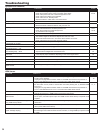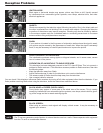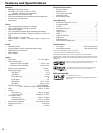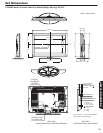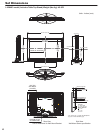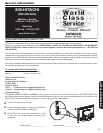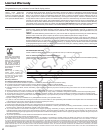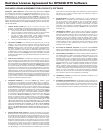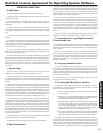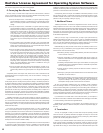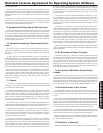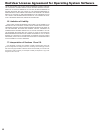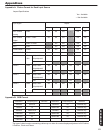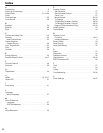
46
End User License Agreement for Operating System Software
this License to apply to the other parts of the aggregate.
6. Conveying Non-Source Forms.
You may convey a covered work in object code form under the terms of sections
4 and 5, provided that you also convey the machine-readable Corresponding Source
under the terms of this License, in one of these ways:
a) Convey the object code in, or embodied in, a physical product (including a
physical distribution medium), accompanied by the Corresponding Source
xed on a durable physical medium customarily used for software inter-
change.
b) Convey the object code in, or embodied in, a physical product (including a
physical distribution medium), accompanied by a written offer, valid for at
least three years and valid for as long as you offer spare parts or customer
support for that product model, to give anyone who possesses the object
code either (1) a copy of the Corresponding Source for all the software
in the product that is covered by this License, on a durable physical me-
dium customarily used for software interchange, for a price no more than
your reasonable cost of physically performing this conveying of source, or
(2) access to copy the Corresponding Source from a network server at no
charge.
c) Convey individual copies of the object code with a copy of the written offer
to provide the Corresponding Source. This alternative is allowed only occa-
sionally and noncommercially, and only if you received the object code with
such an offer, in accord with subsection 6b.
d) Convey the object code by offering access from a designated place (gratis
or for a charge), and offer equivalent access to the Corresponding Source
in the same way through the same place at no further charge. You need
not require recipients to copy the Corresponding Source along with the
object code. If the place to copy the object code is a network server, the
Corresponding Source may be on a different server (operated by you or a
third party) that supports equivalent copying facilities, provided you main-
tain clear directions next to the object code saying where to nd the Cor-
responding Source. Regardless of what server hosts the Corresponding
Source, you remain obligated to ensure that it is available for as long as
needed to satisfy these requirements.
e) Convey the object code using peer-to-peer transmission, provided you in-
form other peers where the object code and Corresponding Source of the
work are being offered to the general public at no charge under subsection
6d.
A separable portion of the object code, whose source code is excluded from the
Corresponding Source as a System Library, need not be included in conveying the
object code work.
A “User Product” is either (1) a “consumer product”, which means any tangible per-
sonal property which is normally used for personal, family, or household purposes, or
(2) anything designed or sold for incorporation into a dwelling. In determining whether
a product is a consumer product, doubtful cases shall be resolved in favor of cover-
age. For a particular product received by a particular user, “normally used” refers
to a typical or common use of that class of product, regardless of the status of the
particular user or of the way in which the particular user actually uses, or expects or is
expected to use, the product. A product is a consumer product regardless of whether
the product has substantial commercial, industrial or non-consumer uses, unless such
uses represent the only signicant mode of use of the product.
“Installation Information” for a User Product means any methods, procedures, au-
thorization keys, or other information required to install and execute modied versions
of a covered work in that User Product from a modied version of its Corresponding
Source. The information must sufce to ensure that the continued functioning of the
modied object code is in no case prevented or interfered with solely because modi-
cation has been made.
If you convey an object code work under this section in, or with, or specically for
use in, a User Product, and the conveying occurs as part of a transaction in which
the right of possession and use of the User Product is transferred to the recipient in
perpetuity or for a xed term (regardless of how the transaction is characterized),
the Corresponding Source conveyed under this section must be accompanied by the
Installation Information. But this requirement does not apply if neither you nor any
third party retains the ability to install modied object code on the User Product (for
example, the work has been installed in ROM).
The requirement to provide Installation Information does not include a requirement
to continue to provide support service, warranty, or updates for a work that has been
modied or installed by the recipient, or for the User Product in which it has been
modied or installed. Access to a network may be denied when the modication itself
materially and adversely affects the operation of the network or violates the rules and
protocols for communication across the network.
Corresponding Source conveyed, and Installation Information provided, in accord
with this section must be in a format that is publicly documented (and with an imple-
mentation available to the public in source code form), and must require no special
password or key for unpacking, reading or copying.
7. Additional Terms.
“Additional permissions” are terms that supplement the terms of this License by
making exceptions from one or more of its conditions. Additional permissions that are
applicable to the entire Program shall be treated as though they were included in this
License, to the extent that they are valid under applicable law. If additional permis-
sions apply only to part of the Program, that part may be used separately under those
permissions, but the entire Program remains governed by this License without regard
to the additional permissions.
When you convey a copy of a covered work, you may at your option remove any
additional permissions from that copy, or from any part of it. (Additional permissions
may be written to require their own removal in certain cases when you modify the
work.) You may place additional permissions on material, added by you to a covered
work, for which you have or can give appropriate copyright permission.
Notwithstanding any other provision of this License, for material you add to a cov-
ered work, you may (if authorized by the copyright holders of that material) supple-
ment the terms of this License with terms:
a) Disclaiming warranty or limiting liability differently from the terms of sections
15 and 16 of this License; or
b) Requiring preservation of specied reasonable legal notices or author at-
tributions in that material or in the Appropriate Legal Notices displayed by
works containing it; or
c) Prohibiting misrepresentation of the origin of that material, or requiring that
modied versions of such material be marked in reasonable ways as differ-
ent from the original version; or
d) Limiting the use for publicity purposes of names of licensors or authors of
the material; or
e) Declining to grant rights under trademark law for use of some trade names,
trademarks, or service marks; or
f) Requiring indemnication of licensors and authors of that material by anyone
who conveys the material (or modied versions of it) with contractual as-
sumptions of liability to the recipient, for any liability that these contractual
assumptions directly impose on those licensors and authors.
All other non-permissive additional terms are considered “further restrictions”
within the meaning of section 10. If the Program as you received it, or any part of it,
contains a notice stating that it is governed by this License along with a term that is a
further restriction, you may remove that term. If a license document contains a further
restriction but permits relicensing or conveying under this License, you may add to a
covered work material governed by the terms of that license document, provided that
the further restriction does not survive such relicensing or conveying.
If you add terms to a covered work in accord with this section, you must place, in
the relevant source les, a statement of the additional terms that apply to those les,
or a notice indicating where to nd the applicable terms.
Additional terms, permissive or non-permissive, may be stated in the form of a
separately written license, or stated as exceptions; the above requirements apply ei-
ther way.
8. Termination.
You may not propagate or modify a covered work except as expressly provided
under this License. Any attempt otherwise to propagate or modify it is void, and will
automatically terminate your rights under this License (including any patent licenses
granted under the third paragraph of section 11).
However, if you cease all violation of this License, then your license from a par-
ticular copyright holder is reinstated (a) provisionally, unless and until the copyright
holder explicitly and nally terminates your license, and (b) permanently, if the copy-
right holder fails to notify you of the violation by some reasonable means prior to 60



